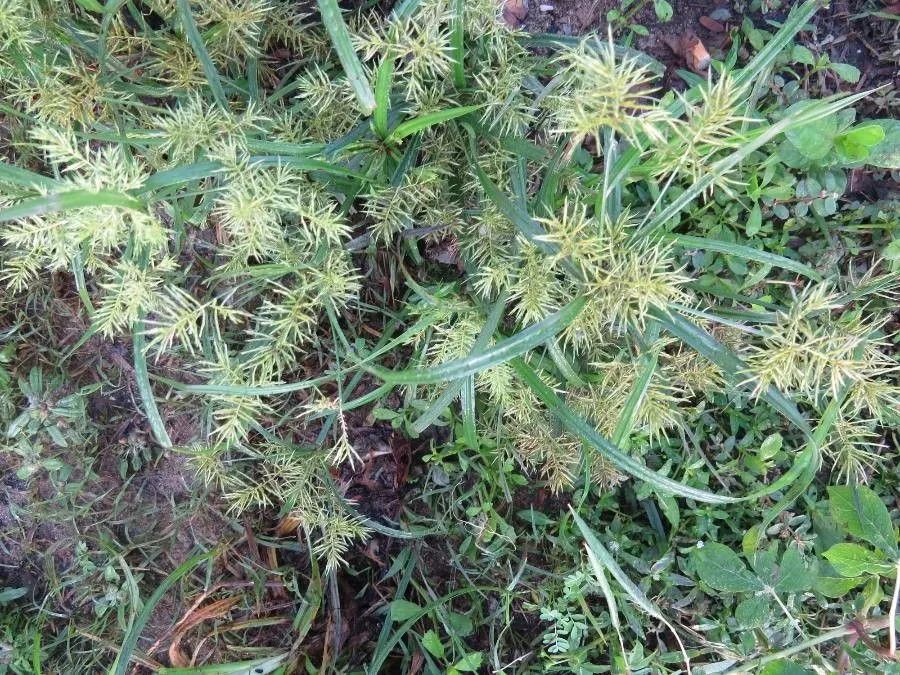
Author: L.
Bibliography: Sp. Pl.: 45 (1753)
Year: 1753
Status: accepted
Rank: species
Genus: Cyperus
Vegetable: True
Observations: Trop. & Subtrop. to N. America
The plant commonly known as Earth-almond, scientifically named Cyperus esculentus, is an intriguing member of the Cyperaceae family. First documented in the authoritative botanical reference “Species Plantarum” published in 1753 by Carl Linnaeus, this plant has captured the interest of botanists and agriculturists alike due to its distinctive properties and wide distribution.
Cyperus esculentus thrives predominantly in tropical and subtropical regions but has also successfully adapted to environments across North America. This hardy species is known for its remarkable resilience and ability to flourish in a variety of soil conditions, making it a versatile plant for many ecosystems. Its unique bulbous roots, often referred to as tubers, are of significant agricultural interest as they are edible and have been cultivated for centuries for their nutritious value.
The Earth-almond is a fast-growing plant, characterized by its grass-like appearance with narrow, linear leaves and small, inconspicuous flowers. These features contribute to its efficiency in colonizing open spaces and disturbed lands, helping to prevent soil erosion and improve soil structure. Despite its beneficial attributes, Cyperus esculentus is also considered a weed in some agricultural settings, where it can compete vigorously with crops for resources.
In addition to its ecological and agricultural relevance, the tubers of Cyperus esculentus, commonly known as “tigernuts,” have been traditionally used in various cultures for their health benefits. These tubers are rich in fiber, vitamins, and minerals, making them a healthy addition to diets and a subject of interest in nutritional studies. They can be consumed raw, roasted, or processed into products like flour and milk, demonstrating the plant’s versatility and economic potential.
Overall, Cyperus esculentus, the Earth-almond, stands out as a plant of considerable importance due to its adaptability, nutritional value, and role in both natural and agricultural systems. Its study continues to contribute valuable insights into sustainable practices and the utilization of lesser-known crops for food security and environmental health.
Eng: chufa (edible variety), earth-almond, edible cyperus, tigernut, water-grass, yellow nut sedge, yellow nut-grass, yellow nutgrass, yellow nutsedge, yellow nutgrass,, perennial yellow flatsedge, earth almond, earth nut, tiger nut, yellow nut grass
Deu: erdmandel, essbares zypergras
Nld: knolcyperus
Fra: souchet comestible, souchet sucré, souchet tubéreux, amande de terre, choufa
Ita: zigolo dolce, cipero dolce
Spa: cebollín, chufa, juncia avellanada
Por: chufa, tiririca, tiririca-amarela
Swe: jordmandel
Hun: mandulapalka
Dan: fladaks
Ara: habb el-‘aziz
En: Earth-almond, Tigernut, Water-grass, Yellow nut sedge, Yellow nut-grass, Yellow nutsedge, Chufa (edible variety), Yellow nutgrass,, Edible cyperus, Yellow nutgrass, Perennial yellow flatsedge, Earth Almond, Earth Nut, Tiger Nut, Yellow nut grass, Chufa Flatsedge, Yellow Nut-sedge, Rush nut, Chufa, Nut flatsedge
Ar: Habb El-‘Aziz, Assis, Habb el ‘aziz, حب الزلم، سقيط (سُقّيط), حب العزيز (حَب العزيز), سعد (سِعْد، سَعْد)، ديس (دِيس), سمار (سَمار، سُمار)
Ca: Xuflera
Da: Fladaks
Nl: Knolcyperus, Aardamandel
Fr: Amande de terre, Choufa, Souchet comestible, Souchet sucré, Souchet tubéreux, Souchet sultan, Souchet vigoureux, Souchet robuste
De: Erdmandel, Essbares Zypergras, Eßbares Zypergras, Chufanuss, Erdmandelgras, Tigernuss
Hu: Mandulapalka
It: Zigolo dolce, Cipero Dolce, Babagiggi, Doldichini
Ko: Gireumgol
Pt: Chufa, Tiririca, Tiririca-amarela, Junca, Tochufa
Pt-br: Tiririca, Tiririca-amarela, Tiririca-mansa
Es: Cebollín, Juncia avellanada, Chufa
Sv: Jordmandel
Taken Sep 4, 2021 by Anna Spirina (cc-by-sa)
Taken Oct 4, 2021 by Jurgen (cc-by-sa)
Taken Oct 4, 2021 by Jurgen (cc-by-sa)
Taken Oct 4, 2021 by Jurgen (cc-by-sa)
Taken Apr 19, 2018 by Javier Castillo (cc-by-sa)
Taken Jul 13, 2014 by Tela Botanica − Florent Beck (cc-by-sa)
Taken Jul 10, 2015 by Tela Botanica − Pat DESNOS (cc-by-sa)
Taken Aug 28, 2022 by William Coville (cc-by-sa)
Taken Aug 15, 2018 by Lisa J (cc-by-sa)
Taken Oct 26, 2021 by Carbajal Guerrero (cc-by-sa)
Taken Jul 25, 2021 by Crystal Graley (cc-by-sa)
Taken Dec 21, 2021 by kalpataru barik (cc-by-sa)
Taken Aug 28, 2022 by William Coville (cc-by-sa)
Taken Sep 27, 2021 by stephen greene (cc-by-sa)
Taken Oct 4, 2021 by Jurgen (cc-by-sa)
Taken Jun 18, 2018 by Manuel Portela (cc-by-sa)
Taken Dec 24, 2017 by vini (cc-by-sa)
Taken Aug 15, 2018 by Spolaor Dino (cc-by-sa)
Taken Jun 10, 2018 by Martin Allan (cc-by-sa)
Taken Nov 6, 2013 by EOL − naturalist eve (cc-by-nc)
Taken Jan 1, 1970 by Photoflora – L’Abbé COSTE (©)
Taken Oct 15, 2011 by Photoflora – Benoit BOCK (©)
Taken Jun 13, 2020 by buisan jose (cc-by-sa)
Taken Oct 15, 2011 by Photoflora – Benoit BOCK (©)
Taken Sep 20, 2021 by Uebel Matt (cc-by-sa)
© copyright of the Board of Trustees of the Royal Botanic Gardens, Kew.
© copyright of the Board of Trustees of the Royal Botanic Gardens, Kew.
© copyright of the Board of Trustees of the Royal Botanic Gardens, Kew.
Taken Sep 7, 2021 by Philippe Bellin (cc-by-sa)
Taken Aug 15, 2018 by Lisa J (cc-by-sa)
Taken Aug 20, 2014 by EOL − Daniel Carter (cc-by-nc)
Taken Jun 25, 2008 by Tela Botanica − Mathieu MENAND (cc-by-sa)
Taken Sep 14, 2022 by Rajka Djordjevic (cc-by-sa)
Growth form: Rhizomatous
Growth habit: Graminoid
Growth rate: Rapid
Ph maximum: 7.0
Ph minimum: 5.0
Light: 8
Atmospheric humidity: 6
Soil nutriments: 6
Soil salinity: 1
Family: Myrtaceae Author: (F.Muell.) K.D.Hill & L.A.S.Johnson Bibliography: Telopea 6: 402 (1995) Year: 1995 Status:…
Family: Rubiaceae Author: Pierre ex A.Froehner Bibliography: Notizbl. Bot. Gart. Berlin-Dahlem 1: 237 (1897) Year:…
Family: Sapindaceae Author: Koidz. Bibliography: J. Coll. Sci. Imp. Univ. Tokyo 32(1): 38 (1911) Year:…
Family: Asteraceae Author: A.Gray Bibliography: Pacif. Railr. Rep.: 107 (1857) Year: 1857 Status: accepted Rank:…
Family: Fabaceae Author: Medik. Bibliography: Vorles. Churpfälz. Phys.-Ökon. Ges. 2: 398 (1787) Year: 1787 Status:…
Family: Aspleniaceae Author: (Cav.) Alston Bibliography: Bull. Misc. Inform. Kew 1932: 309 (1932) Year: 1932…